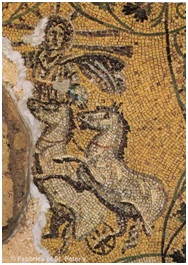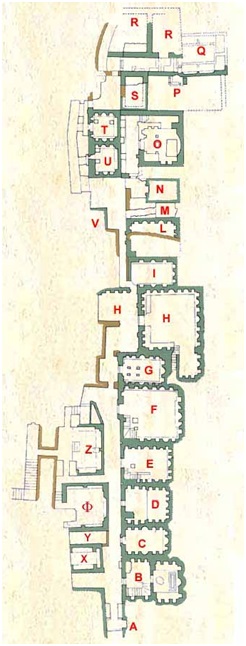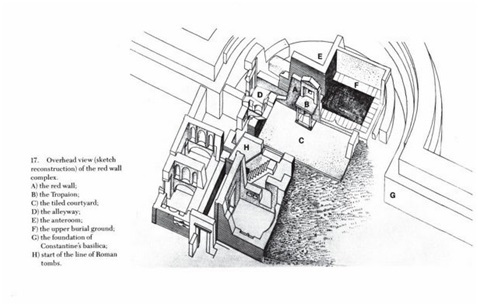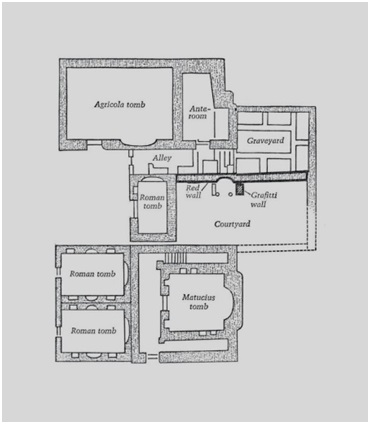The Vatican Scavi

Excavations in Search of St. Peter’s Grave in Rome

by Michael J. Hartwig, Ph.D. – Illume Scholar-in-Residence
February, 2017
One of the most important early Christian sites in Rome is the “Scavi” or the Vatican excavations under St. Peter’s Basilica. The Scavi tour is highly coveted as the Vatican only allows 200 people a day into the site. Local guides do a great job of explaining its significance and identifying various elements of the visit, but most visitors leave with more questions and group leaders wished they had more information in advance so they could better prepare people for what they will experience. This essay provides some initial orientation and perspective for your visit.
One of the reasons for pilgrimage to the Holy Land, Turkey, Greece, Rome and other sites of great historical and religious significance is to connect with the people, places and events of history. It is not so much that we are doubting Thomases. Rather, people gain a solidity as we visit sites associated with their lives. They take on flesh and blood and become real. This happens to those who journey under the magnificent basilica of St. Peter’s and find the humble grave of a Galilean fisherman who had the boldness to come to Rome to share the vision of his teacher, Jesus, and to lead a young community of disciples who sought to challenge Roman power and foster a new world built on compassion, love, and justice.
In 1939, workmen were changing the level of the pavement in the grotto under the main floor of St. Peter’s Basilica in preparation for the tomb of Pope Pius XI. In addition to finding sarcophagi that had been placed in the earth under the church, they discovered a brick wall which descended very deeply into the ground. After some initial excavations, they realized they had discovered a large pagan mausoleum. Since this was during World War II, Pope Pius XII authorized further “secret” excavations in hope that they would shed more light on the origins of the basilica and the tomb of St. Peter.
 What the archaeologists discovered was nothing short of amazing. They found numerous richly decorated pagan mausoleums. Some included cubicles for ashes of cremated relatives, others included richly decorated marble sarcophagi. Most were adorned with traditional pagan funerary art and symbols, but a few included images which were either Christian or crypto-Christian (symbols that Christians might recognize as Christian but their pagan neighbors might still consider pagan – thus hiding their religious allegiance). For example, in one mausoleum, there is a beautiful mosaic of Christ portrayed as the sun on a chariot traversing the heavens. For the family which was now Christian, Christ is the light of the world but, for their pagan neighbors, the image of Christ could easily have been taken for Apollo or Mithras or other Sun-god figures.
What the archaeologists discovered was nothing short of amazing. They found numerous richly decorated pagan mausoleums. Some included cubicles for ashes of cremated relatives, others included richly decorated marble sarcophagi. Most were adorned with traditional pagan funerary art and symbols, but a few included images which were either Christian or crypto-Christian (symbols that Christians might recognize as Christian but their pagan neighbors might still consider pagan – thus hiding their religious allegiance). For example, in one mausoleum, there is a beautiful mosaic of Christ portrayed as the sun on a chariot traversing the heavens. For the family which was now Christian, Christ is the light of the world but, for their pagan neighbors, the image of Christ could easily have been taken for Apollo or Mithras or other Sun-god figures.
Image from Vatican Scavi of Christ as the Sun/Light of the World.
The findings confirmed information previously believed about the Vatican site. For centuries a large obelisk had stood to the left of St. Peter’s Basilica. When the new St. Peter’s Basilica was built in the 16th century, the Pope had the obelisk moved to the center of St. Peter’s Square (in 1585). Historians knew that the obelisk stood on the center spine of the circus of Caligula and Nero (where St. Peter and other early Christians were martyred). They also knew that Constantine erected the first basilica here, in 324, because he believed this was the site of the tomb of St. Peter. Little evidence, however, had been found of a cemetery.
The excavations confirmed the presence of an extensive pagan cemetery. Since this was an area outside the original city walls, it was suitable for wealthy families to build mausoleums. The cemetery was located on the hillside overlooking the oblong arena in the valley. The discovery of the cemetery helped reinforce the possibility that St. Peter and other Christian martyrs could have been buried in this area after their deaths nearby. This, in turn, helped substantiate the long-held belief that Constantine built the original basilica over the grave of St. Peter.
Most of the large mausoleums were pagan with only a few Christian burials and markings (probably from families who converted in the late 4th century). The first part of the Scavi tour includes visits to these impressive Roman family tombs. None of these date before the 2nd century, so they were not contemporary with St. Peter’s grave. There were some repositioned bones in some of the mausoleums which would suggest that there were earlier burials on the hillside which had to be incorporated into the new, more lavish tombs. (Walsh, 27) This is important since it would help support the idea that some Christians or Christian sympathizers could have stolen Peter’s body from the arena and buried it in a simple grave on the hillside (similar to other simple graves at that time).
The initial excavations did not confirm that St. Peter was buried here. So, the archaeologists sought permission from the pope to continue excavations – even up to and under the high altar where, ideally, St. Peter’s tomb would be located. He gave permission to proceed. It was a risky area for excavation and the stakes were high. If St. Peter’s tomb and relics were not found, this would be embarrassing on many levels.
There is little early outside historical evidence about Peter being buried in Rome. An unreliable reference was made in the Acts of Peter to his being laid in the tomb of a Roman senator and a more reliable one made later, in the year 200, by Gaius (a priest) who in a private letter refers to a trophaion of Peter (a memorial, shrine or trophy). (Walsh, p. 37) Walsh thinks that the absence of references to St. Peter’s tomb in early Christian literature reinforces the idea that early Christian leaders wanted to conceal its location. (Walsh, 134)
The most important evidence for Peter’s being buried here was Constantine’s basilica. Why would the emperor alienate noble Roman families by leveling a cemetery and desecrating tombs in order to build a monument to a previously persecuted sect? In one of the pagan tombs, coins were found dating to the time of Constantine. Thus, the cemetery was still active when he filled in the mausoleums with dirt and built the basilica over them.
 For centuries, St. Peter’s tomb was one of the most important pilgrimage destinations in the world. The belief that Peter led the early Christians at Rome and died for his faith supported the claim that the succeeding leaders of the church at Rome (the bishops of Rome/popes) possessed the authority St. Peter had been given by Jesus before his death. (Matthew 16:18) For many, this was nothing less than the authority of heaven and earth – the keys to the Kingdom of God. Indeed, in the 16th century when the old St. Peter’s Basilica needed to be rebuilt, popes and architects envisioned nothing less than a monument large enough to re-center the world around Rome. Threats from the Ottoman Empire, the spreading Reformation in northern Europe, the discovery of new continents by European explorers, and new theories about a heliocentric or even non-centric universe all de-centered the classical and Catholic world order. St. Peter’s Basilica – built on the tomb of the Galilean fisherman who had been given authority to lead the Church – was to reinforce a Roman-centric world.
For centuries, St. Peter’s tomb was one of the most important pilgrimage destinations in the world. The belief that Peter led the early Christians at Rome and died for his faith supported the claim that the succeeding leaders of the church at Rome (the bishops of Rome/popes) possessed the authority St. Peter had been given by Jesus before his death. (Matthew 16:18) For many, this was nothing less than the authority of heaven and earth – the keys to the Kingdom of God. Indeed, in the 16th century when the old St. Peter’s Basilica needed to be rebuilt, popes and architects envisioned nothing less than a monument large enough to re-center the world around Rome. Threats from the Ottoman Empire, the spreading Reformation in northern Europe, the discovery of new continents by European explorers, and new theories about a heliocentric or even non-centric universe all de-centered the classical and Catholic world order. St. Peter’s Basilica – built on the tomb of the Galilean fisherman who had been given authority to lead the Church – was to reinforce a Roman-centric world.
The 1940’s excavations under the main altar of St. Peter’s were complicated. Many of the structures would have to remain in place. Archaeologists had to crawl through narrow spaces and imagine the extension of certain surfaces beyond the excavated area. For most visitors to the Scavi, this is where the tour becomes complicated and hard to envision since we cannot see what the archaeologists found.
Here is a map of the area that visitors see under St. Peter’s. The first part of the tour traces the street or narrow passage between rows of mausoleums (spaces D, E, F, G, H, I, M, N, U, T). The later part of the tour concerns areas R, Q and P.
Here is a link to an interactive map with opportunity to click on various sections to learn more: http://stpetersbasilica.info/Necropolis/Scavi-map.htm
At the end of the street between the mausoleums, one enters the area directly under the main altar of St. Peter’s. Here is a diagram of that area.
 The diagram shows the apse of the 4th century church (G) built around the shrine (B) that marks St. Peter’s grave.
The diagram shows the apse of the 4th century church (G) built around the shrine (B) that marks St. Peter’s grave.
An alley (D) was discovered with a mausoleum-like space (E) on the left. Within this space there is a cistern (Walsh, 64). At the top of the alley was a courtyard (F) with spaces for burial. Since there was no provision here for cremation, archaeologists believe this was a Christian burial space reserved for bishops. (Walsh, 65) On the right side of the alley was a red wall (A). On the right side of the wall – in the direction of the front of St. Peter’s basilica, are the remnants of a shrine (what the archaeologists believe Gaius referred to when he spoke of a trophaion erected at Peter’s tomb) (B). There are two pillars that support a small shelf. To the right of these two pillars is a wall that juts out perpendicular to the red wall. It is covered in graffiti. The space in front of the shrine (C) and to its right is large enough for a gathering of approximately 60-70 people (Walsh, 142).
Modern visitors can only see small parts of the trophaion, a section under the red wall believed to be the original site of St. Peter’s tomb, and part of the graffiti wall. These are viewed from the side and back (partially from the alley running parallel to the red wall and partially from behind the trophaion in the Clementine chapel that is part of the current church grottos).
The results of the excavations led to the following conclusions by archaeologists. After the fire of Nero in 64 AD and the martyrdom of Christians, including Peter, in Nero’s circus, Peter’s body was absconded and taken up the hillside to be buried, perhaps in land belonging to a wealthy sympathizer. (The bones they found and believe to have been St. Peter’s lack feet bones, consistent with the story that St. Peter was crucified.) For the next hundred years, the location of St. Peter’s grave would have been a carefully guarded secret amongst the small Christian community at Rome. (Walsh, 134)
In the middle of the 2nd century, the political climate led Christians to feel bold enough to encircle an area with a wall and erect a memorial to Peter on the site. The memorial (or trophaion) was built in typical pagan form and included no distinguishing Christian symbols or references to St. Peter. Archaeologists in the 1940’s found that the “red wall” which was built in around 150 AD, included an inverted “V” at the bottom. This protected the pre-existing grave underneath. (Guarducci, 23-24) Coins and bones were found in the cavity under the inverted “V.” Some coins date back to the time of Augustus, underscoring a devotion to this site from the 1st century. (Walsh, 66) There were other graves found adjacent to the one under the red wall and memorial. These graves were positioned in an odd fashion – as if to be as close as possible to the grave under the memorial. (Walsh, 65-66)

The memorial would not have caught the attention of pagans visiting family tombs in the area. It is possible that several other adjoining areas made up a primitive church. The “ante-room” and its cistern could have served as a baptismal area. The “graveyard” was a space reserved for the burial of important leaders in the early community – perhaps their bishops (popes). The larger “courtyard” would have been used for Eucharists. According to Walsh, if all of this is true, this may be one of the earliest churches in the world as most Christians, during the 2nd century, met in homes (Walsh, 146).
In the late 3rd century, the red wall, along which the memorial was attached, began to crack. A small supporting wall was erected to hold it in place. This wall was found by the archaeologists, and it was covered in graffiti. At first the markings were disappointing since reference to St. Peter seemed absent and therefore did not help to confirm whether this was or wasn’t his grave.
The wall also included a marble-lined receptacle. In the early stages of excavation, the opening to this was narrow. One of the archaeologists, Antonio Ferrua, was poking around the area when he noticed a fragment of masonry that was lying inside. It appeared to be a piece of plaster from the red wall that must have broken loose during some of the work. On the piece, Ferrua found a Greek inscription, “petr . . . eni” or “Peter is here.” (Walsh, 75)
Dr. Margarita Guarducci was called in to decipher the graffiti on the wall. She discovered lots of Christian names but no reference to Peter. Later work, in the 1950’s, led to new discoveries. What they found were the letters “P” or “PE” sometimes in a unique monogram where the P and E looked like a key -  or
or  . PE are the first letters of Peter’s name, and the key symbol was associated with his receiving the keys to the Kingdom of God. References to Christ were in the form of the “chi-rho,” the symbol that was used to refer to Christ. Another puzzle in the archaeological project arose when Guarducci, working on the graffiti inscriptions, asked Msgr. Vacchini if anything else had been found in the receptacle. Vacchini mentioned that Msgr. Kaas was present when the opening had been enlarged and a number of bone fragments were found. The fragments were all placed in a wooden box for safe keeping. (Walsh, 81-90) Guarducci asked to see them and was instrumental in having them analyzed.
. PE are the first letters of Peter’s name, and the key symbol was associated with his receiving the keys to the Kingdom of God. References to Christ were in the form of the “chi-rho,” the symbol that was used to refer to Christ. Another puzzle in the archaeological project arose when Guarducci, working on the graffiti inscriptions, asked Msgr. Vacchini if anything else had been found in the receptacle. Vacchini mentioned that Msgr. Kaas was present when the opening had been enlarged and a number of bone fragments were found. The fragments were all placed in a wooden box for safe keeping. (Walsh, 81-90) Guarducci asked to see them and was instrumental in having them analyzed.
Archaeologists were baffled by the presence of some bones in the grave under the trophaion and by those found in the graffiti wall receptacle. John Walsh believes that during several particularly dramatic persecutions, Christians took the bones of Peter from the grave under the trophaion and put them in the graffiti wall to hide them (replacing the ones under the trophaion with others). Later, St. Peter’s bones were repositioned under the trophaion. But, under Diocletian’s persecution at the end of the 3rd century and the beginning of the 4th century, they were again placed in the graffiti wall (leaving some other bones in St. Peter’s actual grave). When Pope Sylvester showed Constantine where the tomb of St. Peter was, he didn’t share with him where the actual remains were. Even though Constantine’s support of Christianity was welcomed, Pope Sylvester must have feared a succeeding emperor could change course. He kept the remains of Peter in the graffiti wall and had Constantine’s architects preserve the graffiti wall when they created a marble monument around the trophaion. This helps explain why the niche and pallia are oddly centered when the graffiti wall could have easily been removed to make it more symmetrical. (Walsh, 131-146)
The bones found in the cavity under the red wall and the bones held in the graffiti wall were examined. Those under the red wall included remains of several individuals and even bones of animals. This wasn’t decisively inconclusive about their being Peter’s relics, but they did raise a lot of questions that were never answered. When they began to study the bones found in the graffiti wall, they discovered they belonged to only one individual. All of the bones of the individual were present except for the feet (consistent with the story of St. Peter being crucified). The age of the individual was determined to be between sixty and seventy years. The individual seemed to be robust. Some bones included soil matching that of the ground in the original cavity believed to have been Peter’s grave. (Walsh, 99-107)
The result of the excavations and the examination of graffiti, coins, and markings, led archaeologists to conclude that, indeed, this was St. Peter’s grave. The analyses of the bones, particularly those taken from the graffiti wall, led most archaeologists to conclude that these are, indeed, St. Peter’s relics.
Those who have an opportunity to visit the Scavi enjoy an inspiring journey to the earliest years of Christianity. The chance to see the magnificent Roman mausoleums is a window into the belief and practices of ancient Roman religion. Pilgrims see and touch what is, perhaps, one of the earliest churches in the world and the place where the first generations of Christians maintained a connection with one of Jesus’ first disciples. Modern visitors, like these early Christians, have a tangible connection to the humble Galilean fisherman who died nearby, was buried here, and inspired succeeding generations to carry on his ministry. Moreover, the visit helps people understand the successive stages of building – from an early Roman cemetery to Constantine’s basilica in 324 and to the current basilica built in the 1500s.
Bibliography and Resources:
Banner Image: By Blue 439 (Own work) [CC BY-SA 3.0 (http://creativecommons.org/licenses/by-sa/3.0)], via Wikimedia Commons. Modifications have been made to color.
Guarducci, Marghareta. Peter, The Rock On Which The Church Is Built. Translated by Patrick Coveney. Fabbrica di S. Pietro in Vaticano. 1977. (Image of Christ the Sun comes from this text)
Guarducci, Marghareta. The Tomb of St. Peter. Hawthorn Books. 1960.
Walsh, John Evangelist. The Bones of Saint Peter: The First Full Account of the Discovery of the Apostle’s Tomb. Double Day, Garden City, 1982 (citations are from the 1982 edition), Sophia Institute Press, 2011 (3D image of the area around the trophaion and the floor plan of the early church come from the 2011 electronic edition). (Walsh’s book is a comprehensive but accessible account of the excavations and the studies made of the bones found there.)
A great resource for the Scavi and for the entire St. Peter’s Basilica is a website called St. Peter’s Basilica Info. The site includes a section on the Scavi and reproductions of Guarducci’s and Walsh’s writings. It includes maps and images (the interactive map comes from this site): http://stpetersbasilica.info/
For information about visiting the Scavi, visit the Scavi office website: http://www.scavi.va/content/scavi/en.html
Back to Bibliography
